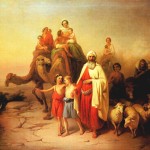And now we turn to Where and When, the most telling of the early Kingdom sayings. In Thomas 3, 51, and 113 and Luke 17:20-21 it is explicitly anti-apocalyptic. Thomas repeats three times that the Kingdom is already present, but people do not see it, and Luke beautifully says that the Kingdom is “among you.” Matthew, as he is wont to do, is just as assertive in the other direction.
The difference here is that while these sayings are all similar, there is actually an important distinction between the apocalyptic and non-apocalyptic ones. Only in the non-apocalyptic sayings does the word “kingdom” actually appear. The apocalyptic passages all refer not to the Kingdom, but to the “Son of Man.”
The term “Son of Man,” which is attributed to the sayings of Jesus throughout the gospels, originates in the apocalyptic visions in the book of Daniel. In the seventh chapter, Daniel is having a prophetic dream of four beasts, one like a lion, one like a bear, one like a leopard, and one that is “different from all the beasts that preceded it” (7:7). The beasts are superseded by the coming of “one like a son of man” (RSV 7:13) or “one like a human being” (NRSV), who will rule “all peoples [and] nations,” and whose dominion “is an everlasting dominion…and his kingship is one that shall never be destroyed” (7:14).
That difference in translation reflects the NRSV’s attempt at modernizing the language of the Bible as well as removing gendered language; the literal translation is “son of man” but the meaning is “human being.”
Now the four feral beasts are identified with great Empires of the ancient world; their identities are disputed, but there is a general consensus that the first is the Chaldean Empire (which had destroyed Solomon’s temple and caused the Babylonian Exile). The Medes, the Persians, the Macedonians, the Seleucids, and the Romans are all seen as possible identifiers for subsequent beasts; generally I find it most believable that the fourth beast represents Alexander’s Macedonains as well as the Seleucids. Consider the explanation of the fourth beast starting at Daniel 7:19, which mentions that, “Out of this kingdom ten kings shall arise, and another shall arise after them” (7:24); this “another” probably represents the Seleucid Empire.
This part of Daniel originates in the mid-2nd century BCE, when the Jewish people were partially-subjugated by Antiochus IV Epiphanes, the ruler of the Seleucid Empire (which eventually led to the Maccabean Revolt). Antiochus outlawed the Sabbath and circumcision, and forced Jews to make pagan sacrifices in the Temple. Consider the very next passage:
“This one shall be different from the former ones…He shall speak words against the Most High, shall wear out the holy ones of the Most High, and shall attempt to change the sacred seasons and the law; and they shall be given into his power for a time, two times, and half a time” (7:24-25). This last part refers to the amount of time the Maccabean revolt lasted (about three and a half years, see 1-2 Macc.).
So Daniel 7 and beyond is essentially Maccabean propaganda claiming that with Maccabean control of the Jewish homeland, the “kingdom of God” or the final climactic kingdom was fulfilled. Son of man is not a title in any sense yet. What eventually happened is that when Jesus began preaching a very different vision of the Kingdom of God (because Maccabean rule obviously didn’t last long and Israel found itself under foreign rule once again), obviously Daniel had to be re-interpreted as a prophecy of things yet to come to pass. So by the 1st century CE, it is conceivable that “Son of Man” could have been used legitimately as a title for the one who would bring God’s climactic, apocalyptic kingdom.
The question remains, however, whether Jesus himself actually used this title. It is used mainly in the synoptic gospels, and always, always by Jesus to refer to himself. It also appears once in Acts (written by Luke) and twice in Revelation, when quoting Daniel 7, but never in the letters of Paul.
Geza Vermes shows definitively in Jesus the Jew (p. 168) that in Galilean Aramaic (the language Jesus spoke), “son of man” (bar nash) was used not infrequently as a circumlocution for “I,” always referring to the speaker. It carried no eschatological or even theological connotations of its own, and no example of it being used as a title (outside the New Testament) exists (Daniel, by the way, was written in Aramaic).
Vermes then charts every single son of man saying in the Synoptics, and the results are striking. If you discount sayings that only appear in Matthew or Luke, but not both (which you should do), only two sayings directly reference Daniel, and both are originally from Mark. 5 reference Daniel indirectly (1 from Mark, 4 from Q), and a whopping 16 have no apocalyptic connotations whatsoever (11 from Mark, 5 from Q).
This, along with other evidence based on philology and history, leads Vermes to conclude:
“…there is no evidence whatever, either inside or outside the Gospels, to imply, let alone demonstrate, that ‘the son of man’ was used as a title. There is, in addition, no valid argument to prove that any of the Gospel passages directly or indirectly referring to Daniel 7:13 may be traced back to Jesus. The only possible, indeed probable, genuine utterances are sayings independent of Daniel 7 in which, in accordance with Aramaic usage, the speaker refers to himself as the son of man out of awe, reserve, or humility. It is this neutral speech-form that the apocalyptically-minded Galilean disciples of Jesus appear to have ‘eschatologized’ by means of a midrash based on Daniel 7:13.” (Vermes 185-186).
Granted that Vermes’s conclusions were controversial at the time they were originally published in the 1960’s, he lists in an appendix several major criticisms of his argument and responds to them in kind. At risk of getting too informal here, I will say unequivocally that I accept his analysis completely.
Because we cannot reliably take the apocalyptic “son of man” logia as authentic sayings of the historical Jesus, the apocalyptic elements of the “Where and When” Kingdom sayings must be seen as later eisegesis by the early Christians. Thus, when we look at all of the early and best-attested Kingdom sayings, the ones most likely to go back to the historical Jesus, we see that they overwhelmingly support a non-apocalyptic eschatology.












